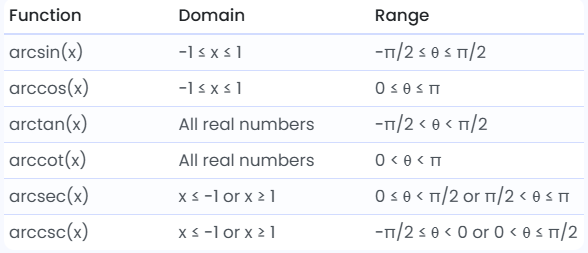1. What is the Inverse Trigonometric Functions Calculator?
Definition: This calculator computes the inverse trigonometric functions (arcsin, arccos, arctan, arccot, arcsec, arccsc) for a given input value \( x \). These functions return the angle whose trigonometric value matches the input.
Purpose: Inverse trigonometric functions are used to find angles in right triangles given the ratios of sides, with applications in engineering, physics, astronomy, and mathematics.
2. How Does the Calculator Work?
The calculator uses the following inverse trigonometric functions:
| Function |
Definition |
Domain |
Range (radians) |
| \( \arcsin(x) \) |
\( \sin(\theta) = x \) |
\( [-1, 1] \) |
\( [-\frac{\pi}{2}, \frac{\pi}{2}] \) |
| \( \arccos(x) \) |
\( \cos(\theta) = x \) |
\( [-1, 1] \) |
\( [0, \pi] \) |
| \( \arctan(x) \) |
\( \tan(\theta) = x \) |
\( (-\infty, \infty) \) |
\( (-\frac{\pi}{2}, \frac{\pi}{2}) \) |
Where:
- \( x \): The input value
- \( \theta \): The angle returned by the inverse function
Unit Conversions (Output Angle):
- Angle (\( \theta \)):
- Degrees (deg): \( \text{deg} = \text{rad} \times \frac{180}{\pi} \)
- Radians (rad): Default output
- Gradians (gon): \( \text{gon} = \text{rad} \times \frac{200}{\pi} \)
- Turns (tr): \( \text{tr} = \text{rad} \times \frac{1}{2\pi} \)
- Minutes of Arc (arcmin): \( \text{arcmin} = \text{deg} \times 60 \)
- Seconds of Arc (arcsec): \( \text{arcsec} = \text{deg} \times 3600 \)
- Milliradians (mrad): \( \text{mrad} = \text{rad} \times 1000 \)
- Microradians (urad): \( \text{urad} = \text{rad} \times 1000000 \)
- π Radians (x π rad): \( \text{x π rad} = \text{rad} \times \frac{1}{\pi} \)
Steps:
- Select the inverse trigonometric function (arcsin, arccos, etc.).
- Enter the input value \( x \).
- Select the desired output unit for the angle.
- Click "Calculate" to compute the angle using the selected function.
- The result is displayed with 4 decimal places in the chosen unit.
3. Importance of Inverse Trigonometric Functions
Inverse trigonometric functions are crucial for:
- Engineering: Calculating angles in right triangles for construction and design.
- Physics: Determining angles in wave analysis and projectile motion.
- Astronomy: Calculating the position of celestial bodies.
- Mathematics: Solving complex trigonometric equations.
4. Using the Calculator
Example:
Calculate \( \arcsin(0.5) \).
- Select the function "arcsin(x)".
- Enter \( x = 0.5 \).
- Choose the output unit as "deg".
- Click "Calculate" to compute:
- \( \arcsin(0.5) = 30^\circ \)
5. Frequently Asked Questions (FAQ)
Q: What are inverse trigonometric functions?
A: Inverse trigonometric functions (arcsin, arccos, arctan, arccot, arcsec, arccsc) find the angle \( \theta \) such that applying the corresponding trigonometric function to \( \theta \) yields the input value \( x \). For example, \( \arcsin(x) \) finds \( \theta \) such that \( \sin(\theta) = x \).
Q: Why do arcsin and arccos have restricted domains?
A: The sine and cosine functions range from -1 to 1, so their inverses (arcsin and arccos) are only defined for inputs \( x \) in \([-1, 1]\). Inputs outside this range do not correspond to any real angle.
Q: What are the different angle units?
A: Angles can be measured in various units:
- Degrees (deg): 360° in a full circle.
- Radians (rad): \( 2\pi \) in a full circle.
- Gradians (gon): 400 gon in a full circle.
- Turns (tr): 1 turn is a full circle.
- Minutes of Arc (arcmin): 60 arcmin per degree.
- Seconds of Arc (arcsec): 3600 arcsec per degree.
- Milliradians (mrad): 1000 mrad per radian.
- Microradians (urad): 1000000 urad per radian.
- π Radians (x π rad): Expressed as a multiple of π.
Inverse Trigonometric Functions Calculator© - All Rights Reserved 2025
 Home
Home
 Back
Back
